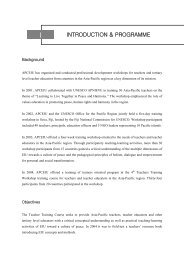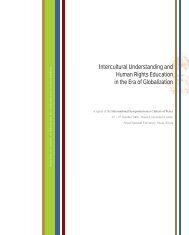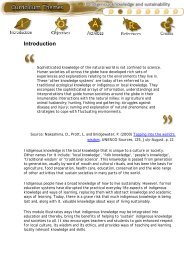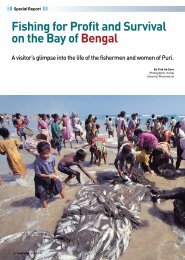REPORT OF UNESCO EXPERT MEETING ON - APCEIU
REPORT OF UNESCO EXPERT MEETING ON - APCEIU
REPORT OF UNESCO EXPERT MEETING ON - APCEIU
Create successful ePaper yourself
Turn your PDF publications into a flip-book with our unique Google optimized e-Paper software.
major challenge for ESD.<br />
Finally, in the promotion of multiculturalism in ESD, insights can now be drawn from the growth of what<br />
is called interfaith dialogue, as representatives of diverse faiths, religions and spiritual traditions are<br />
meeting to more deeply understanding each other’s knowledge and spirituality traditions while respecting<br />
differences. Exemplars of such interfaith dialogue movements include the World Conference on Religions<br />
and Peace, Parliament of the World’s Religions, United Religions Initiative and many local and<br />
grassroots community organizations. I<strong>UNESCO</strong> has also been active in promoting such interfaith and<br />
intercultural dialogue initiatives (e.g. the Declaration on the Contribution of Religions to a Culture of<br />
Peace; the Dialogue of Civilizations). From dialogue and respect has emerged in many contexts a process<br />
of reconciliation and healing of bitterness, enmity and distrust. Most importantly, the different faiths are<br />
finding that they share many common values and ethical principles for guiding relationships among all<br />
peoples and culture nonviolent and just interfaith and intercultural relationship (Mische & Merkling,<br />
2001). In turn, this common ground of shared values should hopefully lead to collaborative action among<br />
all faiths to resolve common societal and global problems (e.g., injustice, violence, human rights<br />
violations, discrimination, racism, and ecological destruction). This was affirmed in the International<br />
Symposium on “Cultivating Wisdom, Harvesting Peace” held at the Multi-Faith Centre, Griffith<br />
University, in Aug, 2005, with the support of <strong>UNESCO</strong>, various National Commissions of <strong>UNESCO</strong>,<br />
<strong>UNESCO</strong> centres and offices, and diverse faith, interfaith and educational institutions (Toh & Cawagas,<br />
2006). As elaborated in the next fifth theme of educating for a culture of peace, the role of faiths and<br />
spirituality traditions in helping to develop a consciousness of sustainability should be tapped in ESD.<br />
(e) Cultivating Inner Peace<br />
The four previous themes of building a culture of peace and the links with ESD have focused mainly on<br />
visible relationships and structures of human life. However, there is a growing recognition among peace<br />
educators that that the inner dimensions and sources of peaceful values and practices should be equally<br />
cultivated, given the realities of feelings of alienation, loss of meaning, and an epidemic of depression<br />
and despair, especially in affluent societies. This education for inner peace draws deeply the insights and<br />
wisdom from the teachings of prophets, saints, and sages of diverse faiths and spirituality traditions,<br />
One increasingly practiced though not necessarily the only strategy for developing inner equilibrium and<br />
tranquility lies in diverse methods of meditation and contemplation. However, it is important to not reduce<br />
meditation to a ‘technique”, but rather as part of a holistic process of spiritual growth. Moreover, in<br />
educating for a culture of peace, the theme of cultivating inner is mindful that inner peace should not be<br />
sought for by a self in a disconnected way to the search for outer peace or building a peaceful world. As<br />
the engaged Buddhists and basic Christian communities have, for example, emphasized, peoples of faith<br />
and spirituality also cultivate a strong responsibility to work for nonviolent, loving, compassionate and<br />
just relationships, structures and a world community. In Islam, while the greater “jihad” is to struggle for<br />
inner purification, Muslims are also called to practice social justice in society and the world.<br />
Considering now the principles and values of ESD, and recalling the analysis made in the preceding<br />
pages of its linkages with other themes of educating for a culture of peace, it is not difficult to see how<br />
cultivating inner peace is also in accord with sustainability. Thus when faiths and spirituality traditions<br />
educate their followers to gently see through the illusions of excessive materialism, power, greed,<br />
unkindness, and violence, and other attachments (e.g. power, status, fame etc), they are more likely to<br />
reconsider the ideology of over-consumerism, fetish of “brands or logos or fashion, and the reduction of<br />
“happiness” to “quantity” rather than quality” of life. Through cultivating greater inner peace, a person is<br />
more inspired to consider what is referred to as voluntary simplicity based on lifestyles and interpersonal<br />
and social relationships that uphold sustainability, justice, nonviolence, respect and loving kindness for all<br />
beings and the planet (Burch, 2000; Thich, 1996).<br />
Not surprisingly, there is now considerable interest in “green theology”, whereby different faiths are<br />
examined as inspirational sources of environmental values toward the vision of a shared global ethic. The<br />
ideas and work of Christian theologians and environmental advocates (e.g. Thomas Berry, Sean<br />
McDonagh, Matthew Fox ) and engaged Buddhists (e.g. Joanna Macy, Sulak Sivaraksa, Thich Nhat Hanh)<br />
are a few exemplars in this regard (McDonagh, 1994; Sivaraksa, 2001). This link between faith and<br />
ecological sustainability is illustrated by the following commentaries on various traditions:<br />
73








